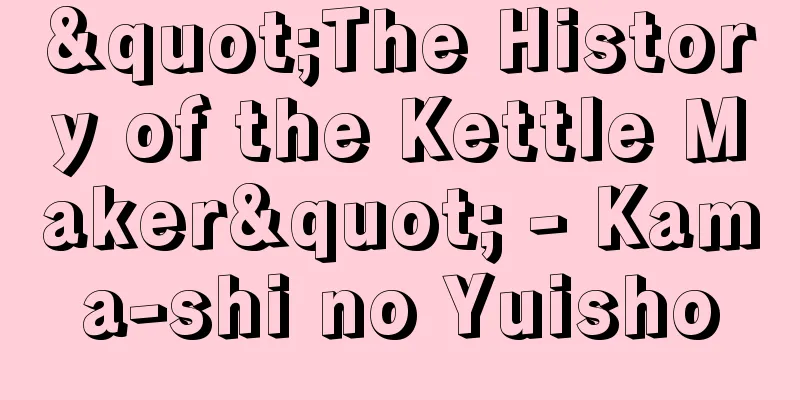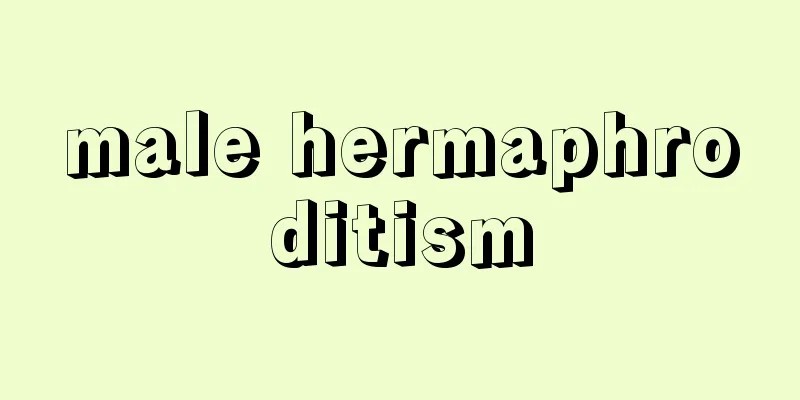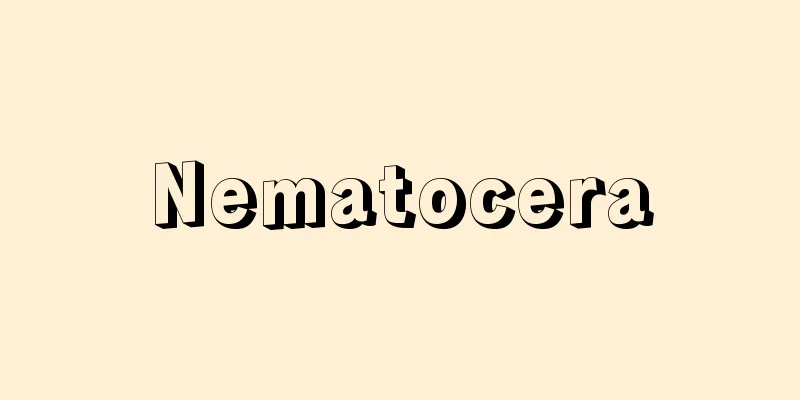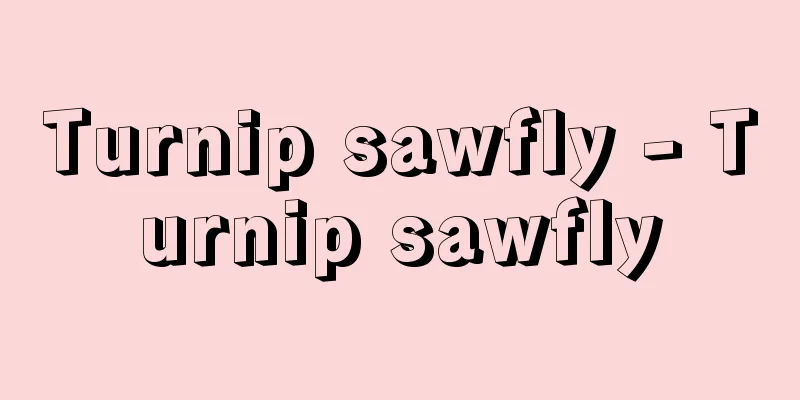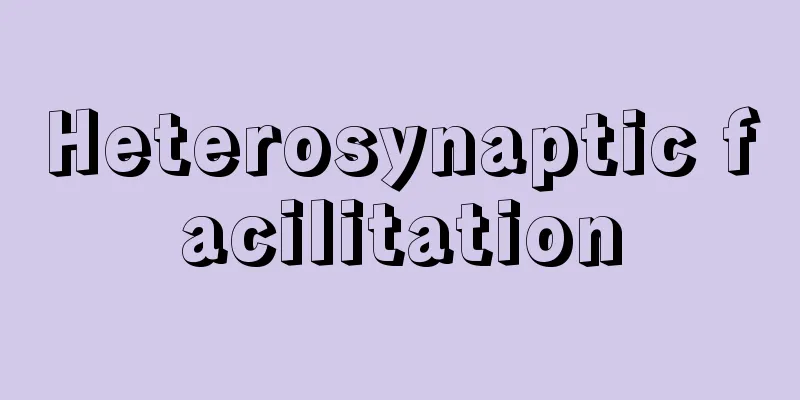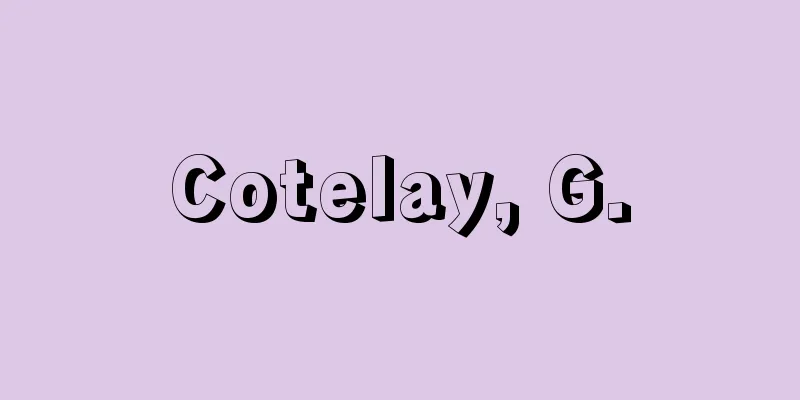Fireworks - Hanabi (English spelling)
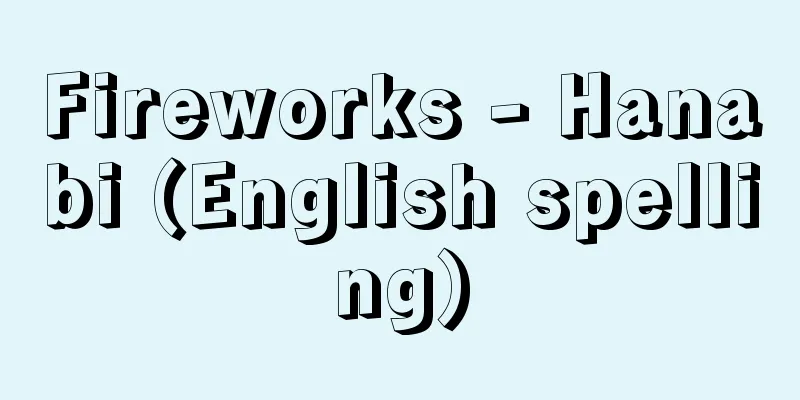
|
The art of using fire is generally called fire art, and among these, the artistic field is called fireworks. In other words, fireworks are primarily for viewing purposes, skillfully combining the light, sparks, sparks, sound, and smoke that occur when gunpowder explodes or burns, and can refer to the phenomenon itself or to items made to represent that phenomenon. The official term for fireworks is "enka," and their manufacture, storage, sale, etc. are regulated by the Explosives Control Law. [Takeo Shimizu and Shingo Date] historyThe original form of fireworks was the "beacon," which had been used since ancient times mainly as a signal in various parts of the world. It is also said that the Trojans used "unextinguishing fire" around 1190 BC, and the Syrians used "Greek fire" in 678. These are thought to be modern-day incendiary agents. However, fireworks only appeared after the invention of black powder (1242), and had spread throughout Europe by the 15th century, centered in Florence, Italy. However, fireworks at that time were monochromatic, and it was not until the 19th century that they began to have the bright colors we see today. [Takeo Shimizu and Shingo Date] The History of Fireworks in JapanIt seems that fireworks were introduced to Japan by the Dutch or Portuguese during the Tensho period (1573-1592) along with general fireworks, but their origin is unclear. According to records in the Sunpu Seijiroku, Imperial Secret Strategy, and Butoku Henenshu, on August 3, 1613 (Keicho 18), a Ming merchant guided an Englishman to visit Tokugawa Ieyasu in Sunpu and present him with guns and telescopes. On the 6th, the Ming merchant set off fireworks in the outer bailey of the castle, which Ieyasu watched. This is said to be the oldest reliable record of fireworks. The Englishman was John Saris, and he came to Japan as an envoy of King James I with a letter of sovereignty. The above document says that "fireworks were set off," so it is likely that he filled a tube with black powder, set it up, ignited it, and watched the sparks shoot upwards. In 1615, the Ise Dance became popular in Sunpu, and there is a record that Chinese people were asked to make fireworks for the occasion (Sunpu Seijiroku). Thus, at first, fireworks were commissioned from foreigners, but gradually Japanese people began to make them themselves, and it appears that they became quite popular in the city of Edo. In 1658 (Manji 1), the first Kagiya came to Edo from Shinohara Village (present-day Shinohara, Ooto-cho, Gojo City) in Yamato Province (Nara Prefecture). For generations, Kagiya has continued under the name Shinohara Yahee for 12 generations, and currently the Amano family has taken over and calls themselves "Soke Hanabi Kagiya" (Edogawa-ku, Tokyo). During the Bunka era (1804-1818), Kagiya's head clerk, Seishichi, branched off and took the name Tamaya, but was driven out of Edo after starting a fire in his own house on April 17, 1843 (Tenpo 14), the day before Shogun Ieyoshi was due to leave Edo to visit Nikko. Currently, the Nakajima family of Yachiyo City, Chiba Prefecture, claim to be the "Original Tamaya". The first Ryogoku River Opening Fireworks Festival is said to have taken place on May 28, 1733 (Kyoho 18). The year before, the Great Kyoho Famine hit Japan, with over 900,000 people said to have died of starvation, and cholera (today's disease) was prevalent in Edo, with the dead abandoned on the streets. The shogunate held a Water God Festival to commemorate the dead and ward off disease, and began to set off fireworks the following year. While European fireworks were cylindrical balls, Japanese fireworks have developed into spherical ones with round, well-balanced flower shapes. Today, Japan's fireworks manufacturing and launching techniques are among the best in the world. [Takeo Shimizu and Shingo Date] Elements and Variations of Fireworks - TypesThere are four phenomena used in fireworks: light, sound, smoke, and something in the form of flags, balloons, flyers, etc. These are the elements of fireworks. Next, there is the changing form of the phenomenon. This is called "Kyoku." The origin of this word is unclear, but it seems to come from the word "Kyoku" in acrobatics. Fireworks move differently from paintings, so the way they change is an issue. In the broadest sense, all fireworks are made up of "Kyoku." However, it is usually used in a narrower sense, such as "Kyokudou" ("Kyoku" meaning trajectory), where a small firework is attached to a launched ball, and the ball explodes as it rises. Next, there are basic types of fireworks based on their structure and purpose. Generally, the types of fireworks are based on this classification. [Takeo Shimizu and Shingo Date] Fireworks lightHistorically, there are two types of fireworks: Japanese fire (wabi) and Western fire. Japanese fire is an ancient Japanese fire that is mainly made of a mixture of saltpeter, sulfur, and charcoal, i.e. black powder, and is mainly made up of charcoal sparks. Western fire is mainly made up of colored fire agents that were brought to Japan from Europe after the Meiji period, and luminous agents such as aluminum and magnesium. Today, these fireworks are made up of a combination of their strengths and weaknesses. Scientifically speaking, there are two types of firework light. One is caused by the light emitted by solids or liquids, and the other is caused by the light emitted by gases. Sparks and embers are the former, and colored fire (flames) are the latter. When solids or liquids are heated to high temperatures, they change from red to red-orange, golden, or white as the temperature rises. The color also varies depending on the type of charcoal or metal components in the agent (i.e., it is a flame color reaction of the elements). Charcoal sparks generally glow faintly in a red-orange color. This is called "hiki." It is named after the phenomenon that looks like a trail of sparks. It is also called "kiku" (chrysanthemum). Pine charcoal is used as the raw charcoal. Aluminum sparks are bright, and depending on the temperature, they change from red-orange to a beautiful golden color, and at higher temperatures they change to yellow-white. This golden color is called "nishiki." Traditionally, this light was short-lived (2-3 seconds), but in the early 1960s, new materials such as titanium were used to create a golden-colored light with a longer lifespan. This is called "coconut." By mixing special metal vapors with high-temperature (over 2300°C) gas (flame), it is possible to emit primary colors such as red, yellow, green, and blue. The agent created in this way is called a colored fire agent. Potassium chlorate or potassium perchlorate is mixed with resins such as shellac to generate a high-temperature flame, and a small amount of a color-producing substance is added to it. Strontium carbonate is used for red, sodium oxalate for yellow, barium nitrate for green, and Paris green or copper oxide for blue. Since the Meiji period, it has become possible to increase the temperature of the flame to about 2500-3000°C by mixing magnesium into the colored fire agent, making it possible to make the light even brighter. Since the 1970s, agents that burn in a flashing manner have also been used. [Takeo Shimizu and Shingo Date] The sound of fireworksThere are three kinds of noises: (1) explosions (thunder), (2) roars (bees), and (3) vibrations and combustion (whistle). (1) Explosive sounds (thunder) Thunder is used as a signal at athletic meets, and is mainly made from a mixture of potassium perchlorate and fine aluminum powder. There are electric lightning, which has a higher aluminum content, and flower lightning, which has titanium mixed in to give off a glow at night. This type of agent becomes difficult to explode when the amount in one packet becomes extremely small. Thus, a mixture of potassium chlorate, sulfur, and red phosphorus is used for pistol balls used as signals at competitions and as toys. This mixture is very sensitive, and it is extremely dangerous to break it up and collect it . Also, toy fireworks (cracker balls) are made from potassium chlorate and realgar As2S2 , and similar care is required with these. (2) Growl (bee) A bee is made by tightly packing black powder into a strong paper tube with asymmetrical openings for the combustion gases to escape. As the tube burns, it makes a kind of spiral motion, producing the sound it makes. (3) Vibration Combustion Sound (Whistle) A whistle is made by filling one end of a long, thin tube with special chemicals (such as potassium benzoate and potassium perchlorate) and leaving an empty space of about 5 centimeters. When the empty end is ignited, it produces a sharp vibration sound similar to that of a whistle. Its natural frequency is about 3000 vibrations per second. A whistle has a propulsive action similar to that of a rocket, and is sold as a whistle rocket among toy fireworks. By appropriately combining the three elements of thunder, bees, and whistles, a kind of musical firework can be created. However, fireworks are generally viewed from a certain distance, and there is a discrepancy between the speed of light and sound. There is also the relationship between rhythm and ignition technology, and these remain as a future challenge. [Takeo Shimizu and Shingo Date] Fireworks smokeScientifically speaking, there are two types of smoke from fireworks: physical smoke and chemical smoke. Physical smoke is smoke that is generated by the physical phenomenon of evaporation. When a substance A with a high boiling point and a substance B with a low boiling point are heated together, they evaporate and become a homogeneous mixture of A and B. During the cooling process, A first appears as liquid or solid particles, and B prevents these particles from sticking together. Therefore, smoke of fine particles of A is obtained. In fireworks, a pigment with a high boiling point is used as A. For red, a mixture of rhodamine B and para red, for yellow, a mixture of phthalocyanine blue and oil yellow, for green, and for blue, phthalocyanine blue. For B, combustion gas from a heat generating agent is used. This agent is made of potassium chlorate and lactose, and when it is mixed with a pigment and ignited, it burns at a low temperature. The heat causes the pigment to evaporate, and at the same time, it creates a homogeneous mixture with its own combustion gas, which is released into the air. The gas is cooled near the outlet, and the pigment turns into fine particles and appears as smoke. The size of these particles is about 2 micrometers or less. Chemical smoke is a chemical product of the combustion of substance A, and works in the same way as cigarette smoke. It is used in fireworks to produce black smoke. It is carbon smoke produced by the combustion of a mixture of anthracene, sulfur, and potassium perchlorate. [Takeo Shimizu and Shingo Date] Flags, balloons, flyers, etc.They are mainly made of thin paper, folded into firework balls that are opened in the air and used for viewing and advertising. Flags are suspended from the top by a parachute and have weights such as sandbags attached to the bottom. Balloons and paper lanterns are bag-shaped and float gently in the air. They have holes that let in air, and lead weights are attached to the edges of the holes. These are called "fukuromono." [Takeo Shimizu and Shingo Date] Fireworks StructureThere are three types of fireworks: (1) launch fireworks, (2) trick fireworks, and (3) toy fireworks. The structure of each type is described below. [Takeo Shimizu and Shingo Date] FireworksThere are two types: Warimono, which appear as a circular flower shape in the air, and Poka, which simply release and deploy the contents of the ball. Warimono have a strong outer shell that is exploded with a strong explosive, hence the name, while Poka have a weak outer shell that is split in two with a weak explosive, hence the name comes from the sound of the explosion. When you lift them up, Warimono feel heavy, while Poka feel very light. The former are about twice as heavy as the latter. Inside the broken ball, stars (spherical lumps of medicine that emit light) are lined up on the outside and the broken medicine is packed tightly inside. When a flower core is needed, a core star is placed in a concentric sphere. This is called a heart mono. When there are two hearts, it is called a yae heart. The stars have a rapeseed or grain core and become gradually thicker as colored fires and pigments are applied to the outside. When a different color is desired, a different corresponding pigment is applied. For example, for "hikisaki beni", the red paint is applied at the beginning of the production of the star, and then the pigment is applied. The star begins to burn from the outside as soon as it blooms, so the pigment appears first, followed by the red color. Poka is a general term for fireworks in which the outer shell of a ball splits in two in the sky, and they are divided into various types depending on their contents. However, there are two types in terms of structure. In one type, the inside of the ball is just a combustion chamber, where all the contents ignite. In the other type, the inside of the ball is divided into a combustion chamber and a fire chamber, which are separated by a partition or similar, and the combustion chamber contains things like stars that must be ignited, while the fire chamber contains things like flags and bags that must not be ignited. The partition can be made of cardboard, cottonseed, rice husks, sawdust, etc. There are two types of fireworks: nighttime and daytime. Nighttime fireworks are dominated by light, while daytime fireworks are dominated by smoke, flags, bags, etc. The sound is the same for both days and nights. The size of a firework ball was measured by the inside diameter of the launch tube, and was measured in units of sun. Nowadays, due to the implementation of the metric system, sun has been replaced by go, for example a 5 sun ball is called a 5 go ball. The actual diameter of the ball is about 90% of the inside diameter of the launch tube. The largest ball today is 40 go (4 shaku). The shape of the breakmono when it blooms into a circle is called a bon. Its diameter varies greatly. [Takeo Shimizu and Shingo Date] Trick fireworksA mechanism is a type of trick that uses gunpowder. Various types can be made depending on the ingenuity, but they are generally simple automatic devices that use gunpowder to create a single effect. Typical examples include frame mechanisms and rapid-fire mechanisms (starmines). Frame mechanisms are made by attaching a row of long, thin tubes (lances) filled with colored fireworks to a wooden frame according to the original design, and igniting them all at once to create images of scenery, people, etc. This includes the "Niagara Falls" that is often seen at fireworks festivals. Rapid-fire mechanisms are made by lining up many small launch tubes, each loaded with about two balls, and launching them in succession, and are an application of launch fireworks. Of the approximately 8,500 fireworks festivals held in Japan each year, some of the most famous are the Tsuchiura National Fireworks Festival, held in Tsuchiura, Ibaraki Prefecture, in early October every year; the Sumida River Fireworks Festival, held in Sumida Ward, Tokyo, in late July every year; and the Omagari National Fireworks Festival, held in Daisen, Akita Prefecture, in late August every year. [Takeo Shimizu and Shingo Date] Toy fireworksMany of them are similar to fireworks and come in a wide variety of types. However, they are characterized by the fact that they use an extremely small amount of propellant, making them non-hazardous. Sparklers are a typical example of traditional Japanese fireworks. Black powder-based chemicals produce little gas when burned, and 60 to 70 percent of the chemical remains as ash. This contains a large amount of potassium sulfide, which shrinks into a round ball of fire, the surface of which reacts with oxygen in the air and burns slowly. The properties of charcoal are important as a raw material for sparklers. Easily flammable charcoal (pine charcoal, paulownia charcoal, etc.) is mixed with a small amount of less flammable charcoal (oil smoke, pine soot, etc.). The former is necessary for the initial combustion of the chemicals, and the latter remains in the fireball and explosively produces pine needle sparks from the surface of the fireball. [Takeo Shimizu and Shingo Date] "The Story of Fireworks" by Shimizu Takeo (1976, Kawade Shobo Shinsha) " ▽ "A Study of Japanese Fireworks" by Kokatsu Gosuke (1979, Mainichi Shimbun)" ▽ "The Story of Fireworks" by Eguchi Harutaro (1982, Chunichi Shimbun)" ▽ "The Science of Energetic Materials: Fundamentals and Applications" by J.A. Conklin, supervised translation by Yoshida Tadao and Tamura Shozo (1996, Asakura Shoten)" ▽ "The Science of Fireworks" by Hosoya Masao (1999, Tokai University Press)" ▽ "A Hundred Flowers of Fireworks" by Onozato Kiminari (2000, Maruzen) ▽ "Fireworks Photo Collection" by Saeki Kazuma, text by Shiraishi Mami (2003, Bunkasha)" ▽ "Introduction to Fireworks Science" edited by Yoshida Tadao and Ding Datoku (2006, Pleiades Publishing, released by Gendai Suugakusha)" ▽ "An Illustrated Guide to Fireworks" by Izumiya Gensaku (2007, Poplar Publishing)" ▽ "Handbook of Energetic Materials, 2nd Edition, edited by the Explosives Society and supervised by Tamura Shozo (2010, Kyoritsu Shuppan)" ▽ "The Mysteries of Fireworks - Does the Number of Fireworks Depend on How You Count? What are the Official Standards for Beautiful Fireworks?" by Saeki Kazuma (2011, Softbank Creative)" ▽ "Explosives Science, 1st Edition, edited by the Japan Explosives Manufacturers Association Materials Editorial Department (2012, Japan Explosives Manufacturers Association)" ▽ "Fireworks - The Art of Fire" by Ogatsu Gosuke (Iwanami Shinsho)" ▽ "Japanese Fireworks" by Onozato Kiminari (Chikuma Shinsho)" [References] | | | | |The fireworks in the picture were also called daimyo fireworks, and were the work of samurai. They were based on signal fire technology for communication, and were distinct from the fireworks of townspeople such as Kagiya, who were also popular . ( Owned by the National Diet Library ) Hiroshige Utagawa "One Hundred Famous Views of Edo: Fireworks at Ryogoku" (1) Tamazume: Fill the inside wall of a paper container called Tamakawa with stars, then place a wariyaku (a medicine wrapped in Japanese paper) in the center. A fuse is attached to one side of the hemisphere, and the other hemisphere is joined together and the seams are glued together. (2) Tamagashi: This is the process of regularly attaching strips of Japanese paper or craft paper to the spherical firework, and is repeated several dozen times with a drying period in between. This is the most labor-intensive process in the production process . The production process of fireworks For multiple launches using the star mine method. The worker is holding a No. 3 rocket (a 3-inch rocket). ©Shogakukan "> Launch tube A nishikie (colored woodblock print) depicting children playing with fireworks. In the Edo period, as launching fireworks became popular, toy fireworks such as sparklers and mouse-shaped fireworks became popular among the common people. This nishikie is said to be a satire of the conflict between the shogunate and the new government forces during the Boshin War. "Children Playing with Fireworks" Diptych ( Owned by the National Diet Library ) Toy fireworks Source: Shogakukan Encyclopedia Nipponica About Encyclopedia Nipponica Information | Legend |
|
火を扱う技術を一般に火術というが、そのなかでも芸術的な分野をなすものを花火という。すなわち花火は、火薬などが爆発しまたは燃えるときの光、火花、火の粉、音、煙などを巧みに組み合わせて、主として観賞の用に供するもので、その現象そのものをさすこともあれば、その現象を現すようにつくられた品物をさすこともある。花火は公的用語としては「煙火(えんか)」といわれ、その製造、貯蔵、販売等は火薬類取締法によって規制されている。 [清水武夫・伊達新吾] 歴史花火の原形に「烽火(のろし)」がある。これは古くからおもに信号として世界の各地で用いられていた。また、紀元前1190年ごろにはトロイ人が「消えない火」を、678年にはシリア人が「ギリシア火」を用いていたと伝えられる。これらは現在の焼夷(しょうい)剤であろうと考えられている。しかし「花火」の出現は、黒色火薬の発明(1242)以後のことで、イタリアのフィレンツェを中心として15世紀ころまでにはヨーロッパ各地に広まっていった。もっともそのころの花火は単色であり、現在のような鮮やかな色をもつようになったのは19世紀になってからのことである。 [清水武夫・伊達新吾] 日本の花火の歴史日本の花火は天正(てんしょう)年間(1573~1592)に一般の火術とともにオランダ人またはポルトガル人によって伝えられたようであるが、起源ははっきりしない。記録によると『駿府政事録(すんぷせいじろく)』『宮中秘策』『武徳編年集成』に、1613年(慶長18)8月3日明(みん)国の商人がイギリス人を案内して駿府に徳川家康を訪ね、鉄砲や望遠鏡などを献上して、その6日には城の二の丸で明人が花火を立て、家康がこれを見物したとある。これが花火についての信頼できるもっとも古い記録であるという。このイギリス人はジョン・セーリスといい、国王ジェームズ1世の使者として国書を持って日本にやってきたのであった。前記の文献に「花火を立てる」とあるから、黒色火薬の薬剤を筒に詰め、これを立てて点火し、その上向きに吹き出す火の粉を観賞したのであろう。1615年には駿府で伊勢(いせ)踊りが流行し、このとき唐人に花火を頼んで飛ばしたという記録もある(駿府政事録)。こうして初めのうちは外国人に頼んで花火を行っていたが、しだいに日本人が自分でつくるようになり、江戸の町では相当に広まったとみえる。1658年(万治1)初代の鍵(かぎ)屋が大和(やまと)国(奈良県)篠原(しのはら)村(現、五條(ごじょう)市大塔(おおとう)町篠原)から江戸へ出てきた。鍵屋は代々篠原弥兵衛(やへえ)を名のって12代まで続き、現在は天野氏が継いで「宗家 花火鍵屋」(東京都江戸川区)を名のっている。なお、文化(ぶんか)(1804~1818)のころ鍵屋の番頭清七が分家して玉屋を名のったが、1843年(天保14)4月17日将軍家慶(いえよし)が日光参拝のため江戸をたつという前日、自家から火事をおこしたため江戸を追われた。現在では千葉県八千代(やちよ)市の中嶋(なかじま)氏が「元祖玉屋」を名のっている。 両国川開き花火は1733年(享保18)5月28日に行われたのが最初であるといわれる。その前年には日本全国に享保(きょうほう)の大飢饉(ききん)があり、餓死者90余万人に達したといわれ、また江戸にはコロリ病(現在のコレラ病)が流行し、死者は路上に捨てられたという。幕府はその慰霊と悪病退散のため水神祭を行い、次の年からは花火も打ち上げるようになった。ヨーロッパの花火が筒形の玉であったのに対し、日本のものは球形で花の形も丸く均斉のとれたものに発達した。現在、日本の花火の製造、打上げ技術は、世界有数のものになっている。 [清水武夫・伊達新吾] 花火の要素と変化形式――種類花火として用いられている現象には四つある。光、音、煙、および旗・風船・ビラなどの形のものであり、これらが花火の要素である。 次に現象の変化形式がある。これを曲という。この語源は明らかでないが、曲芸の曲からきたもののようである。花火は絵画などと異なって動くものであるから、変化の仕方が問題になる。もっとも広い意味では花火はすべて曲からなる。しかし普通狭い意味に使い、たとえば打揚げ(打上げ)玉に別の小花火を取り付け、玉が昇る途中で開花するようにした曲導(導は弾道の意)がある。 次に花火の構造と用途による基本的な形式があげられる。普通に花火の種類というのはこの分類法によるものである。 [清水武夫・伊達新吾] 花火の光歴史的には和火(わび)と洋火とがある。和火は硝石、硫黄(いおう)、木炭の混合物、すなわち黒色火薬を主とした日本古来のもので、炭の火の粉を主にしている。洋火は明治以後ヨーロッパから日本へ伝えられた色火剤(いろびざい)や、アルミニウム、マグネシウムなどの光輝剤が主である。今日ではこれらが長短補って花火を成り立たせている。 科学的にみると花火の光には2種類ある。固体や液体の発光によるものと、気体の発光によるものがこれである。火花や火の粉は前者で、色火(炎)は後者である。固体や液体が高い温度に加熱されると、温度の上昇とともに、赤、赤橙(せきとう)、黄金、白色へと変わっていく。薬剤の中の炭や金属成分などの種類によっても色調が異なる(すなわち、元素の炎色反応である)。炭の火の粉は一般に赤橙色で弱く光る。これを「引(ひき)」という。現象が火の粉の尾を引いていくように見えるのでこの名がある。また別名で「菊」ともいう。原料炭としては松炭が用いられる。アルミニウムの火の粉は明るく、その温度によって赤橙色から美しい黄金色になり、さらに高温では黄白色に変わる。この黄金色を「錦(にしき)」という。従来、この光は短命(2~3秒)であったが、1960年代前半にはチタンなどの新しい原料を用いて黄金色のもっと長い寿命のものもできるようになった。これを「椰子(やし)」という。高温(約2300℃以上)の気体(炎)の中に特殊な金属蒸気が含まれるようにすると、赤、黄、緑、青などの原色光を出すことができる。このようにつくられた薬剤を色火剤という。塩素酸カリウムまたは過塩素酸カリウムとセラックなどの樹脂を混合し高温の炎を発生するようにし、それに少量の色を出す物質を加える。赤に炭酸ストロンチウム、黄にシュウ酸ナトリウム、緑に硝酸バリウム、青にパリスグリーンまたは酸化銅などが用いられる。明治時代以降、色火剤にマグネシウムを混入することにより炎の温度を約2500~3000℃に上昇させ光をいっそう明るくすることができるようになった。1970年代以降は点滅燃焼をする薬剤も用いられるようになった。 [清水武夫・伊達新吾] 花火の音これには3種類がある。(1)爆発音(雷(らい))、(2)唸(うな)り音(蜂(はち))、(3)振動燃焼音(笛)、である。 (1)爆発音(雷) 雷は運動会の合図などに用いられるもので、主として過塩素酸カリウムにアルミニウムの微粉を混合した薬剤が使われる。アルミニウムの分量を多くした電光雷、チタンを混入して夜間に残光を出すようにした花雷(はならい)などがある。この種の薬剤は1包の量が極端に小さくなると爆発しにくくなる。それで、競技の合図や玩具(がんぐ)に使われるピストルの玉には、塩素酸カリウム、硫黄、赤リンの混合薬が用いられる。この混合薬は非常に鋭敏であり、これをほぐして集めるなどの行いはきわめて危険である。また玩具用花火のかんしゃく玉(クラッカーボール)は塩素酸カリウムと鶏冠石(けいかんせき)As2S2との薬剤で、これも同様な注意が必要である。 (2)唸り音(蜂) 蜂は黒色火薬をじょうぶな紙筒に固く詰め、燃焼ガスの吹き出し口を非対称にあけてあるため、燃えながら筒が一種の螺旋(らせん)運動をするために生じる音である。 (3)振動燃焼音(笛) 笛は特殊な薬剤(安息香酸カリウムと過塩素酸カリウムなど)を細長い筒の一端に詰め、5センチメートル程度の空長を残しておく。空長側に点火すると笛に似た鋭い振動音を出すものである。その固有振動数は毎秒3000程度である。笛にはロケットに似た推進作用があり、玩具用花火では笛ロケットとして販売されている。 以上の雷、蜂、笛の三つを適当に組み合わせると一種の音楽花火をつくることができる。しかし、一般に花火はある距離を置いて観賞するものであり、光と音の速度の不一致がある。またリズムと点火技術との関係もあり、将来の課題として残されている。 [清水武夫・伊達新吾] 花火の煙科学的にみると花火の煙には物理煙と化学煙とがある。物理煙とは、蒸発という物理現象により発生する煙のことである。沸点の高い物質Aと低い物質Bとをいっしょにして加熱すると、両者が蒸発していったんAとBとの均一な混合物になるが、これが冷却する過程でまずAが液体または固体の粒子になって現れ、Bはこの粒子相互の付着を妨げる。したがって細かいAの粒子の煙が得られる。花火ではAとして沸点の高い色素を用いる。赤にローダミンBとパラレッドの混合物、黄にオイルエロー、緑にフタロシアニンブルーとオイルエローの混合物、青にフタロシアニンブルーなどである。Bとしては発熱剤から出る燃焼ガスを利用する。この薬剤は塩素酸カリウムと乳糖などからなり、これと色素とを混合して点火すると低い温度で燃える。その熱によって色素が蒸発すると同時に、自らの燃焼ガスと均一な混合ガスをつくり、これが空中に放出される。ガスは放出口の近くで冷却され、色素が微粒子になって煙として現れる。この粒子の大きさは約2マイクロメートル以下である。化学煙は、物質Aが薬剤の燃焼生成物として化学的にできるもので、たばこの煙と原理は同じである。花火では黒煙などに用いられる。これはアントラセン、硫黄、過塩素酸カリウムの混合薬の燃焼によって生じる炭素の煙である。 [清水武夫・伊達新吾] 旗・風船・ビラなどおもに薄い紙の製品であり、花火玉に畳み込んで上空で開かせ、観賞や宣伝広告などに用いられる。旗は上を落下傘で吊(つ)り、下には砂袋などのおもりを下げる。風船や提灯(ちょうちん)などは袋の形をしていて、空中をふわふわと浮遊する。これらには空気をはらむ穴があいていて、その穴の縁に鉛のおもりなどがつけてある。これらを「袋物」という。 [清水武夫・伊達新吾] 花火の構造花火には、(1)打上げ花火、(2)仕掛け花火、(3)玩具用花火がある。それらの構造について記述する。 [清水武夫・伊達新吾] 打上げ花火上空で円形の花形を現す割物(わりもの)と、単に玉の内容物を放出展開させるだけのポカがある。割物は強い外殻を備え、これを強い割薬で破裂させるのでこの名があり、ポカは弱い外殻を弱い割薬でぽかっと二つに割るので、その破裂音からきた名である。持ち上げてみると割物はずしりと重い手ごたえがあり、ポカはいかにも軽い感じである。前者は後者の約2倍の重さがある。 割物の玉の中には、外側に星(光を出す球形の薬のかたまり)を並べ、その内側に割薬をぎっしりと詰める。また花の心(しん)が必要なときは同心球状に心星(しんぼし)を入れる。これを心ものという。二重に心が入ったものを八重(やえ)心という。星はナタネや穀粒を心とし、その外側に色火剤や引をかけだんだんに太くしたものである。色を変えたいときはそれに相当する薬剤に変えてかける。たとえば「引先紅(ひきさきべに)」は星の製造の初めに紅剤をかけ、ついで引をかける。開花と同時に星は外側から燃え始めるので、まず引が現れ、ついで赤色が現れる。 ポカは上空で玉の外殻を二つに割る花火の総称であって、その内容物によってさまざまなものに分かれる。しかし構造としては2種類ある。その一つは、玉の内部が燃焼室だけであり、ここで内容物がすべて着火する。他の一つは、玉の内部が燃焼室と防火室とに分かれ、両者は隔壁などで仕切られ、燃焼室には着火しなければならない星などを入れ、防火室には着火してはならない旗や袋物などを入れる。隔壁にはボール紙、綿実、籾殻(もみがら)、おがくずなどが用いられる。 打上げ花火には、夜の花火と、昼の花火との別があり、夜は光を、昼は煙と旗・袋物などを主体としている。また音は昼夜に共通である。 花火玉の大きさは打上げ筒の内径で表し、寸単位でよばれていた。現在ではメートル法の施行のため、5寸玉を5号玉とよぶなど、寸を号でいいかえるようになった。実際の玉の直径は打上げ筒の内径の9割程度である。現在もっとも大きい玉は40号(4尺)である。割物が円形に開花したときの形を盆(ぼん)という。その直径は非常にまちまちである。 [清水武夫・伊達新吾] 仕掛け花火仕掛けとは火薬を使ったある種のからくりをいう。考案によっていろいろなものができるが、火薬などを使った簡易な自動装置によって一つのまとまった効果を現すものである。代表的なものに枠仕掛けや連発(スターマイン)などがある。枠仕掛けは、木枠などに、原図にあわせ、色火剤を詰めた細長い筒(ランス)の列を取り付け、一斉に点火し、景色や人などの像を現す。花火大会でよく見られる「ナイアガラの滝」もこれに入る。連発は、多数の小さな打上げ筒を並べ、これに筒1本に2個程度の玉を装填(そうてん)し、連続的に打ち上げるもので、打上げ花火の応用である。 日本国内で年間におよそ8500回開催されている花火大会のなかで、毎年10月初旬に茨城県土浦(つちうら)市で行われる土浦全国花火競技大会や、毎年7月下旬に東京都墨田(すみだ)区で行われる隅田川(すみだがわ)花火大会、毎年8月下旬に秋田県大仙(だいせん)市で行われる大曲(おおまがり)全国花火競技大会などが全国的に有名である。 [清水武夫・伊達新吾] 玩具用花火打上げ花火に類似したものが多く種類も雑多である。しかし薬量をきわめて少なくし危険がないようにつくられているのが特徴である。 日本古来の代表的なものに線香花火がある。黒色火薬系の薬剤は燃えてもガスが少なく、薬の6ないし7割が燃えかすとして残る。これには多量の硫化カリウムが含まれていて、丸く縮んで火球をつくり、その表面が空気中の酸素と反応して緩やかに燃える性質がある。木炭の性質は線香花火の原料として重要である。燃えやすい炭(松炭、桐(きり)炭など)に少量の燃えにくい炭(油煙や松煙など)を混合して用いられる。前者は薬剤の初期の燃焼に必要であり、後者は火球の中に残って、爆発的に火球の表面から松葉火花を発生する。 [清水武夫・伊達新吾] 『清水武夫著『花火の話』(1976・河出書房新社)』▽『小勝郷右著『日本花火考』(1979・毎日新聞社)』▽『江口春太郎著『花火ものがたり』(1982・中日新聞社)』▽『J・A・コンクリン著、吉田忠雄・田村昌三監訳『エネルギー物質の科学 基礎と応用』(1996・朝倉書店)』▽『細谷政夫著『花火の科学』(1999・東海大学出版会)』▽『小野里公成著『花火百華』(2000・丸善)』▽『冴木一馬写真、白石まみ文『花火写真集』(2003・ぶんか社)』▽『吉田忠雄・丁大玉編著『花火学入門』(2006・プレアデス出版、現代数学社発売)』▽『泉谷玄作著『花火の図鑑』(2007・ポプラ社)』▽『火薬学会編、田村昌三監修『エネルギー物質ハンドブック』第2版(2010・共立出版)』▽『冴木一馬著『花火のふしぎ――花火の玉数は数え方しだい?美しい花火の正式な基準とは?』(2011・ソフトバンククリエイティブ)』▽『日本火薬工業会資料編集部編『火薬学』初版(2012・日本火薬工業会)』▽『小勝郷右著『花火――火の芸術』(岩波新書)』▽『小野里公成著『日本の花火』(ちくま新書)』 [参照項目] | | | | |画面の花火は大名花火ともいわれた武家の花火で、通信用ののろし技術を基礎とし、共に人気を集めた鍵屋など町人の花火と一線を画していた国立国会図書館所蔵"> 歌川広重『名所江戸百景 両国花火』 (1)玉詰め 玉皮と呼ばれる紙製の容器の内壁に星を詰め、中央に和紙で包んだ割薬を入れる。半球の一方にあげ導(導火線)をつけ、残りの半球と合わせてつぎ目を張り合わせる。(2)玉貼り 球状になった花火に短冊状の和紙やクラフト紙を規則正しく貼り付ける作業で、乾燥期間をはさんで数十回繰り返す。製作過程でもっとも人手のかかる工程である©Shogakukan"> 打上げ花火の製作工程 スターマイン方式の連発打上げ用。作業員が手にしているのは3号玉(3寸玉)である©Shogakukan"> 打上げ筒 花火で遊ぶ子供たちを描いた錦絵。江戸時代、打上げ花火の流行に伴って、庶民のあいだには線香花火や鼠花火などの玩具花火が広まった。この錦絵は、戊辰戦争における幕府と新政府軍の対立を風刺したものといわれる。『子供遊花火の戯』 二枚続国立国会図書館所蔵"> 玩具花火 出典 小学館 日本大百科全書(ニッポニカ)日本大百科全書(ニッポニカ)について 情報 | 凡例 |
Recommend
"The Diary of Prince Asahiko"
…In the same year, he became the chief priest of ...
Youth in the Storm - Arashi no naka no seishun (English title) I Am a Camera
British film. Produced in 1955. A postwar film dir...
Chikka Deva Raja (English spelling)
…The kings of the state have had the title of Uda...
Hachisuka clan
A local warrior who ruled over Hachisuka Village,...
Tang Yin Comparison - Tang Yin
A court case tale from the Song Dynasty in China....
Broqueville (English spelling) Charles Comte de Broqueville
1860‐1940 Belgian politician. He served as a Catho...
William Wyler
American film director. Born in Mulhouse, France ...
Bhillama
...also called the Sevuna dynasty. Bhillama, a va...
GCTU - Global Control University
General Confederation of Trade Unions. The former ...
bends
...These excess gases are expelled or consumed in...
Rubus palmatus (English spelling) Rubus palmatus
… [Matsui Jin]. … *Some of the terminology that m...
Mizutaki - Mizutaki
A type of hot pot dish. It is made by filling a p...
Ijokaku - Ijokaku
…There has long been a teahouse in the area, and ...
SSD - Solid State Disk
A disk drive that uses large-capacity flash memory...
Commander-in-Chief of Oshu
…In August 1335 (Kenmu 2), immediately after the ...
